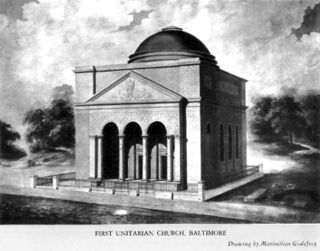First Unitarian Church
| First Unitarian Church | |
|---|---|

| |
| Site Information | |
| Address | 10 W. Franklin Street |
| Geo-reference | 39°17′43″N 76°36′57″W / 39.29529°N 76.6158°W |
| Owner | First Unitarian Church |
| Building Data | |
| Building Type | Church |
| Architectural Style | Neoclassical |
| Design | |
| Architect | Maximilian Godefroy |
| Construction | |
| Completed | 1817 |
| Renovation | |
| Date | 1893 |
| Architect | Joseph Evans Sperry |
The building built in 1817 on a plot of land in Howards Woods purchased for $20,000. It was designed by J. Maximilian M. Godefroy, a French émigré who also designed the St. Mary's Seminary Chapel on North Paca Street on the northwest edge of the City and the Battle Monument in the former Courthouse Square on North Calvert Street between East Lexington and Fayette Streets commemorating the Battle of Baltimore of September 1814 at North Point and the bombardment of Fort McHenry in the War of 1812, and assisted the famed British-American architect Benjamin Henry Latrobe in designing the Baltimore Merchants' Exchange at South Gay Street, between Second (now Water) and East Lombard Streets. Poor acoustics under the central dome led to an 1893 interior renovation, in which architect Joseph Evans Sperry added a barrel vault under the dome. The church features stained glass from the studio of Louis Comfort Tiffany. The pipe organ was donated by Enoch Pratt and is a Niemann instrument. In the rear, on the north side along West Hamilton Street is the Enoch Pratt Parish Hall, also housing church offices, constructed in 1879 of bricks salvaged from the townhouses torn down at West Mulberry at Cathedral Street for the first Central Building of parishioner Enoch Pratt's gift to the City of Baltimore, of a central library and four regional branches in 1882, constructed and opened 1886 (current building replaced it in 1931-33). The Parish Hall was renamed in 2008 to commemorate his influence and guidance in the early years and its interior is being restored to its Victorian appearance.
A relief in the building's pediment was executed by Antonio Cappellano, who had also executed the carvings on the Battle Monument. Deterioration caused it to be replaced with a replica in 1954.